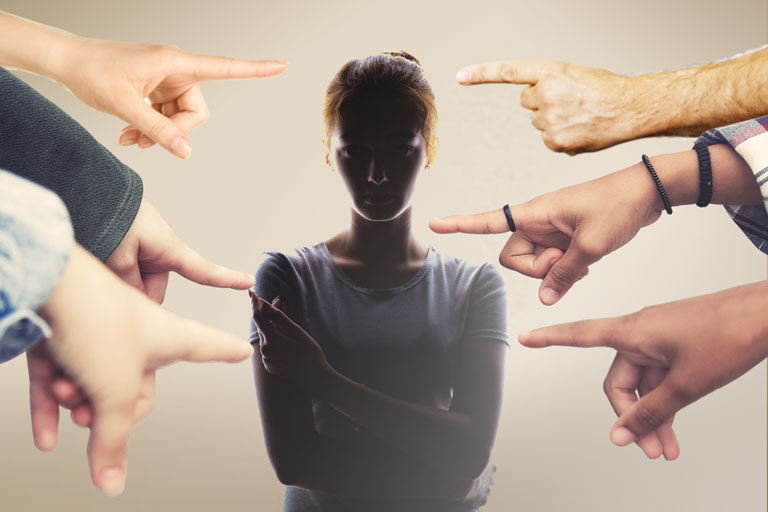Torres
Discrimination is the unequal treatment of a person or group for racial, religious, physical, political, sex, age, physical or mental condition differences, among others. The most common meaning of discrimination refers to the sociological phenomenon in human beings that violates equality.
Most of the people affected by discrimination are individuals belonging to so-called minorities, small groups within a society, although there are many cases in which these groups are not small.
Discriminatory traditions, policies, ideas, practices and laws exist in many countries and institutions throughout the world, including in territories where discrimination is frowned upon. In some places, attempts have been made to benefit those who have traditionally been victims of discrimination through positive discrimination mechanisms, such as the establishment of quota laws to favor the access of women to representative positions or to favor the hiring of people with disabilities.
INDIVIDUAL DISCRIMINATION VERSUS COLLECTIVE DISCRIMINATION AND INSTITUTIONAL DISCRIMINATION
Navarro
We understand by individual discrimination that which occurs between one individual and another. That is, when a person treats another person differently and negatively without a different contextual reason.
Discrimination faces collective discrimination, which occurs when differential treatment is given from one group to another, negative and inferior for the same reasons. Collective discrimination is suffered by LGBT groups, for example, and occurs in cases of racial discrimination, such as in the United States during the 1960s or the pressures suffered by those who profess certain religions in Islamist countries.
DISCRIMINATION BY CRITERIA
Idrovo
AGEISM
Age discrimination is one that discriminates or stereotype based on an individual's age, consisting of a series of beliefs, norms, and values that are used to justify discrimination or subordination, most frequently directed toward older adults or children and adolescents .
DISCRIMINATION BY GENDER
Gender discrimination is a social phenomenon that is based on the set of socially constructed roles, behaviors, activities and attributes that a society considers as appropriate and inappropriate for men and women. It can cause different psychic problems and somatizations in LGBT communities.
When referring to gender discrimination, we understand that it is any distinction, exclusion or restriction in sex that has the object or result of impairing or nullifying the recognition, enjoyment or exercise of a right by gender.
DISCRIMINATION AGAINST WOMEN IN THE WORKPLACE
It is one of the few areas in which women have managed to have job growth, compared to the opposite gender, developing mainly in executive areas and positions that involve a specific academic degree.
The massive increase in this type of work among women in recent years derives from a series of conditions, such as sociodemographic, economic changes, the dispersion of certain traditions and customs, the aging of the population, the growth of the female population, crisis prosecutors, among others, especially in western societies.
DISCRIMINATION AGAINST MALE
In most countries, compulsory military service is compulsory only for men, constituting systematic and institutional violence against men, in many cases endorsed by the courts. When this occurs, this violence also involves other forms of violence and discrimination (military discipline, mobilization for war, subjection to military criminal laws, etc.).
There are also other forms of discrimination and violence against men in other areas.
DISCRIMINATION BY ETHNIC ORIGIN
Poalasin
Ethnic discrimination is a very specific gender of discrimination, since it is directed against individuals or groups that are distinguished by their racial, cultural, national or any other characteristics that associate them with a group that shares a common heritage. The word "ethnic" or "ethnic" comes from the Greek and refers to members of a people or nation who have a shared origin.
Ethnic or racial discrimination is recognized above all in the international arena, where slavery, apartheid and anti-Semitism marked the discussion on this topic in the middle of the 20th century. However, it must be clear from now that the ethnic or racial is not limited to the color or physical features of the group in question, but to a set of objective and subjective elements, such as beliefs, ways of life or institutions that distinguish a people or particular nation.
DISCRIMINATION TO INDIGENOUS WOMEN
One of the worst forms of discrimination is invisibility, indigenous immigrant women are invisible, we do not know precisely how many migrate to the agricultural fields or to the maquiladoras in the north of the country, nor do we know how many migrate to the United States.
This vision has allowed systematic violations of Human Rights, since the groups labeled as vulnerable are limited in the possibilities of exercising their rights, hiding facts that have discriminatory roots due to racists, misogynists, xenophobes, etc. and, above all, inequalities are hidden, which, based on structural determinations, deny or restrict access to decent living conditions.
DISCRIMINATION FOR DISABILITY
Discrimination against people with disabilities has been due to the lack of knowledge of society about this condition, this has prevented them from enjoying their rights (health, work, education, housing, transportation and accessible communications, justice, culture, tourism) and have a full life.
DISCRIMINATION FOR SEXUAL ORIENTATION
The importance of knowing the content and scope of human rights is to be able to exercise them and assert them before the competent bodies. Although the main obligated parties are the authorities and public servants, we must all respect the human rights of people regardless of their orientation, whether they are heterosexual, lesbian, gay, bisexual, transgender, transvestites. For people with different sexual orientations, the most important decisions in life, such as those related to work, home, marriage or whether to adopt or procreate children, are not so easy because of the taboos that still exist, especially in societies like the Mexican where religion has a great weight or influence or the Venezuelan for its cultural patterns. They will probably find it difficult to make these decisions if they do not have the necessary support from the State and the family, schools and society itself.
DISCRIMINATION BY SPECIES
Contreras
Speciesism is a form of discrimination based on membership in a species. It involves treating members of one species as morally more important than members of others even when their interests are equivalent.More precisely, speciesism is the failure to consider interests of equal strength. The notion has been formulated in various ways, in relation to the interests, rights and personal individuality of human beings and animals, in terms of the supposed moral relevance that membership in a species confers.
LATERALITY DISCRIMINATION
In this part, the clearest example is the discrimination of the right-handed towards the left-handed, since in many cultures and religions they consider the left hand as "the hand of the devil". For this and other reasons, years ago, the faculty tried to get left-handed boys and girls to write with the right or "right" hand. The qualities of the human being being equal, that both left-handed and right-handed people have, the treatment should be the same with respect to their laterality.
DISCRIMINATION FOR PREGNANCY
This type of discrimination occurs when women are limited or rejected, when they are pregnant, or suffer from a pregnancy-related illness. Pregnant women have the right to be treated in the same way as those who are not, and they have the right to have access to the same opportunities. A boss or employer cannot deny the hiring of a pregnant woman who meets the requirements of the requested position. As well as the obligation to assign maternity leave, treating the woman in the same way that would treat a temporarily disabled employee.
Regarding medical insurance, in the case of women, it must contemplate and cover those needs related to pregnancy. With respect to other situations, an employer does not have the right to limit the work development of a married woman, due to the possibility that she may become pregnant.
RELIGIOUS DISCRIMINATION
This discrimination can manifest itself in limiting access to education, health services, or public office and even members of religious communities can be imprisoned or killed because of their affiliation or religious beliefs. Furthermore, this form of discrimination may affect those who publicly state that they do not believe in any religion (discrimination against atheists).
DISCRIMINATION BY PERSONALITY
Introverts can be discriminated against and ridiculed, with epithets such as "autistic", "dumb", etc. Where this type of segregation occurs most is in schools, work, daily life. Very closed-minded schools try to force students to get together with others, thus cutting off their personality and development. This type of discrimination is very little spoken, almost legal, indeed, for this reason, this type of discrimination encourages attitudes such as bullying and mobbing.
DISCRIMINATION FOR MENTAL DISORDER
Mentalism or savagery describes the oppression and discrimination of a specific or supposed mental characteristic or condition of a person. This discrimination may or may not be defined in terms of mental disorder or cognitive deficit. Discrimination is based on factors such as neurodivergence stereotypes, for example people with asperger syndrome, learning difficulties, ADHD, bipolar, schizophrenia, and personality disorders, specific behavioral phenomena such as stuttering and tics, or intellectual disability.
RACIAL DISCRIMINATION
Castro
Racism is defined as: "any distinction, exclusion, restriction or preference based on race, color, lineage or national or ethnic origin that has the object or result of nullifying or impairing the recognition, enjoyment or exercise under conditions of equality, of human rights and fundamental freedoms in the political, economic, social, cultural spheres or in any other sphere of public life ”.
DISCRIMINATION FORMS
Bonoso
DIRECT DISCRIMINATION
Discrimination against those who do not belong to a certain group due to the fact that they do not belong to such group or in the belief that those who do not belong to such group do not satisfy some kind of morally relevant criteria.
Direct discrimination occurs when a person with a disability is or has been treated less favorably than someone who is not, in a similar or comparable situation (sex, national origin, race, color, ethnicity, age, disability, or religion) .
COGNITIVE DISCRIMINATION
Two types of discrimination (cognitive and non-cognitive) are distinguished depending on the attitude with which it is carried out. Accordingly, cognitive discrimination is one that is made with respect to those who do not belong to a certain group X based on the belief that a certain morally relevant criterion is not satisfied by those who do not belong to X. This can occur both in cases of direct and indirect discrimination.
NON-COGNITIVE DISCRIMINATION
The discrimination of those who belong to a certain group X due to a mere attitude, to those who do not belong to X (such as the mere wish that they do poorly). It always occurs under direct discrimination.
HIERARCHICAL DISCRIMINATION
Discrimination against those who do not belong to a certain group X implies that some or all of the interests of those who do not belong to X count less than those of those who do belong to X. This is done by seeking some type of segregation.
REFLECTIVE DISCRIMINATION
The discrimination of those who belong to a certain group in which the discriminator is found. Someone may belong to a certain group also discriminating and maintaining such discrimination.
INTERNATIONAL DEALS
Villacis
Important United Nations Organization documents that address discrimination include:
The Universal Declaration of Human Rights is a declaration adopted by the General Assembly of the United Nations on December 10, 1948. It establishes that: "Everyone has the right to all the rights and freedoms established in this Declaration, without distinction of any kind, such as race, color, sex, language, religion, political or other opinion, national or social origin, property, birth or other state. "- The International Convention on the Elimination of All Forms of Racial Discrimination (ICERD) is a United Nations convention. The Convention commits its members to eliminate racial discrimination. The convention was adopted and opened for signature by the United Nations General Assembly on December 21, 1965, and entered into force on January 4, 1969.
- The Convention on the Elimination of All Forms of Discrimination against Women (CEDAW) is an international treaty adopted in 1979 by the United Nations General Assembly. Described as an international declaration of rights for women, it entered into force on September 3, 1981.
- The Convention on the Rights of Persons with Disabilities is an international treaty of United Nations human rights instruments. The parties to the Convention are obliged to promote, protect and guarantee the full enjoyment of human rights by persons with disabilities and ensure that they enjoy full equality before the law. The text was adopted by the United Nations General Assembly on December 13, 2006, and was opened for signature on March 30, 2007. It entered into force on May 3, 2008.























No hay comentarios:
Publicar un comentario